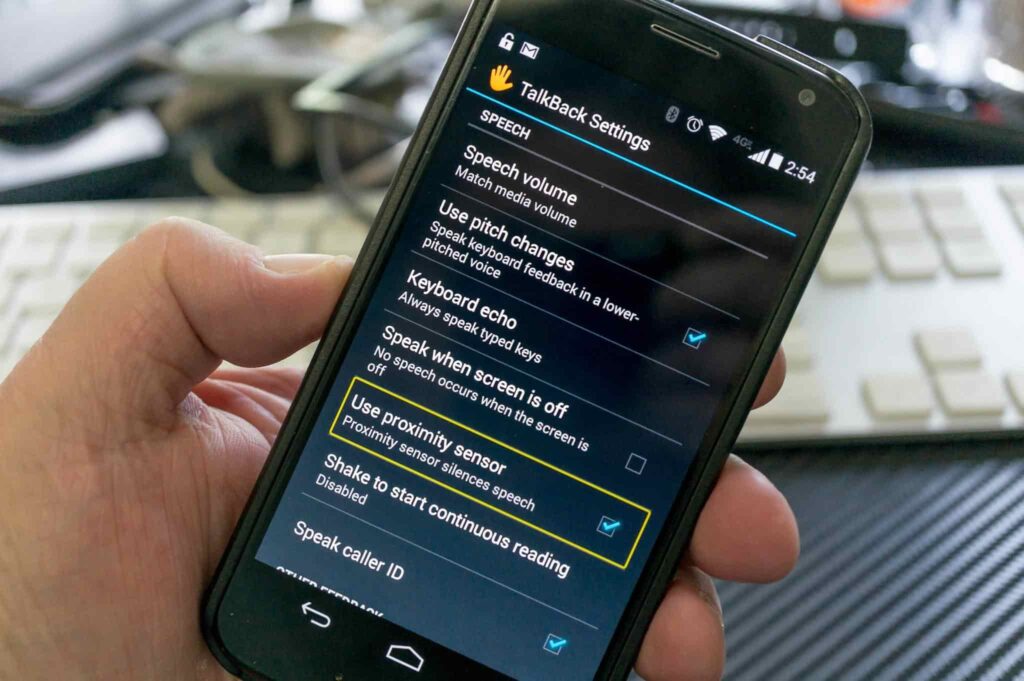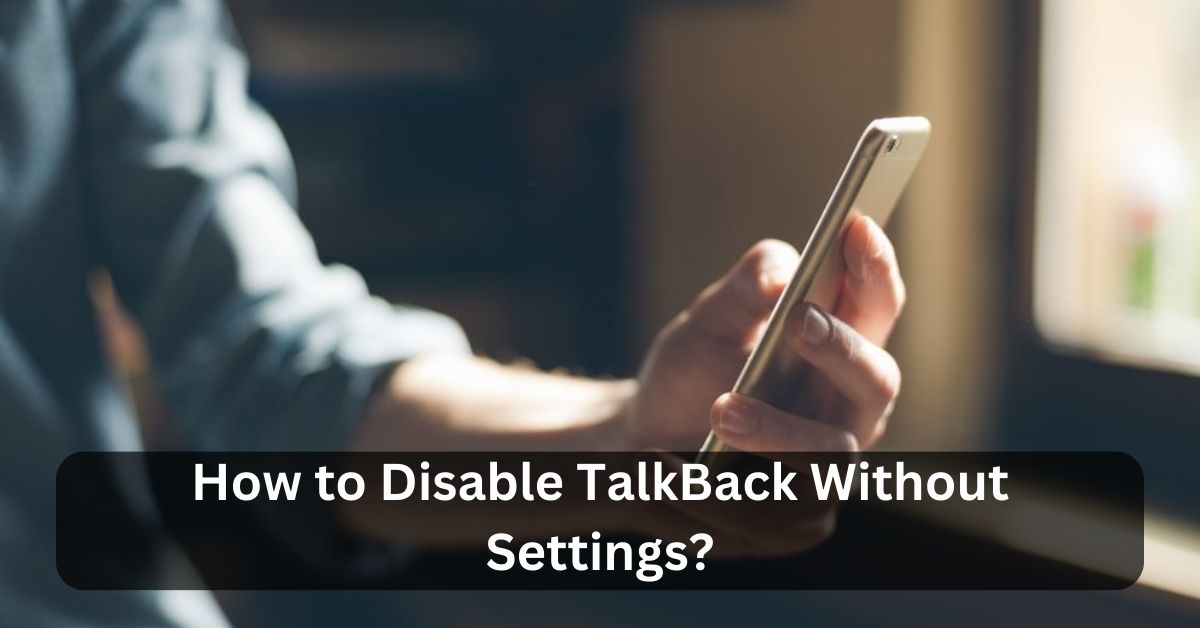How to Disable TalkBack Without Settings? – Click To Unravel!
TalkBack is a crucial accessibility feature designed to assist users with visual impairments in navigating and using their devices. However, there may be instances where temporarily disabling TalkBack is necessary for various reasons.
TalkBack is an accessibility feature designed for individuals with visual impairments. It provides spoken feedback and gestures to help users navigate and use their devices effectively.
This article explores different methods to disable TalkBack without delving into device settings, ensuring a seamless user experience.
Importance of Disabling TalkBack – Access The Detail Effortlessly!
While TalkBack is invaluable for many users, there are scenarios where temporarily turning it off becomes essential. This article explores various methods to achieve this without accessing device settings.

Disabling TalkBack is crucial in certain situations, allowing users to navigate devices without constant spoken feedback.
This flexibility is essential for tasks where auditory guidance may be disruptive, offering a balanced approach to accessibility that caters to individual preferences and needs.
Understanding TalkBack – Explore It Out!
1. TalkBack Features:
TalkBack reads text aloud, describes actions, and enables touch gestures for visually impaired users.TalkBack is an accessibility feature aiding visually impaired users.
It reads aloud text, describes actions, and utilizes touch gestures, enhancing device navigation and interaction for a seamless user experience.
2. Common Reasons to Disable TalkBack:
Users may need to turn off TalkBack temporarily for tasks that may be hindered by constant spoken feedback or when troubleshooting issues.
Users may disable TalkBack temporarily for tasks frustrated by regular vocal feedback or when troubleshooting problems. Balancing accessibility and convenience drives the common need for its deactivation.
Disabling TalkBack Using Settings – Learn The Ins And Outs Now!
The conventional method involves navigating through device settings to disable TalkBack. This section provides a step-by-step guide.

- Unlock Your Device: Ensure your device is unlocked and on the home screen.
- Access Settings: Find and launch your device’s “Settings” application. Typically, you can identify it by its gear icon symbol.
- Navigate to Accessibility: Scroll down and find the “Accessibility” option in the Settings menu. Tap on it to proceed.
- Select TalkBack: Within the Accessibility menu, look for the “TalkBack” option. Touch it to open the TalkBack settings.
- Toggle Off TalkBack: Once inside the TalkBack settings, you’ll find a toggle switch. Simply toggle it off to disable TalkBack.
- Confirm Action: A confirmation prompt may appear, asking if you want to turn off TalkBack. Confirm your choice.
- Verify Deactivation: Return to your home screen and interact with your device. Ensure that TalkBack is successfully disabled by checking for the absence of spoken feedback.
Alternative Methods to Disable TalkBack – Check It Out!
Learn how to utilize the accessibility shortcut for a quicker way to disable TalkBack. Some devices offer the option to disable TalkBack using physical buttons. Explore this alternative method.
Third-party applications that can assist in managing TalkBack settings without delving into device configurations. Disabling TalkBack without accessing settings offers alternative methods for a seamless experience.
Users can utilize the Accessibility Shortcut for quick deactivation, explore physical button options on some devices, or opt for third-party apps for managing TalkBack settings. These alternatives provide flexibility, catering to diverse user preferences and device capabilities.
Addressing Potential Issues – Discover The Facts Now!
Troubleshoot common problems related to TalkBack by ensuring that accessibility settings are configured correctly. Explore tips and tricks to address issues that may arise while disabling TalkBack.

Troubleshoot challenges in disabling TalkBack by ensuring correct accessibility settings. Offers valuable tips to overcome common problems, providing a seamless experience for users navigating their devices without the hindrance of constant spoken feedback.
User Experiences and Testimonials – Gain Your Knowledge!
Read real-life experiences of users who have faced challenges with TalkBack and how disabling it temporarily benefited them. Understand the impact on user satisfaction when users can control TalkBack based on their needs.
User Experiences and Testimonials on Disabling TalkBack Temporarily shed light on real-life scenarios where users found relief.
By sharing stories of overcoming challenges and improving user satisfaction, this section highlights the practical benefits of having the flexibility to control.
TalkBack is based on individual needs, enhancing the overall usability of devices for those with visual impairments.
These narratives provide valuable insights into the impact of temporary TalkBack deactivation on users’ daily lives, fostering a better understanding of the importance of accessibility features and user-driven customization in modern technology.
The Importance of Disabling TalkBack Temporarily – Let’s Learn!
Situations where temporarily turning off TalkBack becomes a necessity for users. Highlight the importance of finding a balance between accessibility features and user convenience. Disabling TalkBack temporarily holds significance in specific scenarios.

Users may need to turn it off when engaged in tasks where constant spoken feedback hinders them, emphasizing the importance of balancing accessibility with user convenience.
By providing flexibility in TalkBack management, individuals can navigate seamlessly through their devices, addressing diverse needs without compromising on the accessibility features that enhance their overall digital experience.
Striking this balance ensures users can tailor their device interactions based on situational requirements, promoting a more inclusive and user-friendly approach to technology.
Tech-Savvy Solutions – Go In Depth!
For users comfortable with advanced settings, this section explores the role of custom ROMs in managing TalkBack—the concept of rooting devices to gain more control over TalkBack settings.
Understand potential security concerns associated with disabling TalkBack and explore workarounds. For tech-savvy users seeking advanced TalkBack control, exploring custom ROMs provides a nuanced approach.
Rooting devices offers intricate settings customization. However, these options require caution and are recommended for users comfortable with the intricacies of modifying their device’s operating system.
Updates and Future Developments – What’s Ahead!
Stay informed about how the tech industry responds to user feedback and challenges related to TalkBack.Explore ongoing research and potential future solutions for TalkBack management.

Discover educational guides and resources for users to understand better and manage TalkBack settings. Highlight the importance of promoting digital literacy among users to empower them in navigating accessibility features.
Learn about organizations actively promoting inclusive technology and accessibility features. Explore how user feedback contributes to improving TalkBack and other accessibility features.
Conclusion:
TalkBack, without delving into settings, offers users flexibility. Balancing accessibility and convenience ensures a smoother user experience, empowering individuals with diverse needs in their device interactions.
Frequently Asked Questions:
1. Can disabling TalkBack affect other accessibility features?
Disabling TalkBack should not affect other accessibility features. However, it’s essential to check individual device settings.
2. Are there risks associated with using third-party apps to manage TalkBack?
While some apps are reliable, users should exercise caution and choose reputable apps from trusted sources.
3. Can TalkBack be temporarily disabled during specific tasks?
Many methods discussed in the article allow users to disable TalkBack for specific tasks temporarily.
4. Is rooting my device necessary for advanced TalkBack control?
Rooting is a progressive step and is only required for some users. Explore other methods first before considering rooting.
5. How often should I check for updates on TalkBack management?
Regularly check for updates, especially after system updates or changes in device settings, to ensure optimal TalkBack management.


